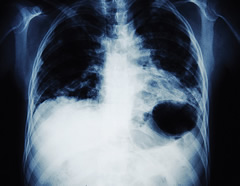Lung cancer is one of the nation’s deadliest diseases, killing more than 20,000 Canadians each year. Early detection is crucial, but current diagnostic methods, such as PET scans, reveal only tumours that have grown to a few millimetres across – at which point the prognosis is poor. Now, researchers at U of T are developing a technique known as “bioplasmonics” that could detect some cancers much earlier, potentially saving thousands of lives.
“Plasmonics” refers to the interaction between light and metal. Shine a light on a metal surface, and electrons are set free, creating an electric field above the surface. In bioplasmonics, these electric fields are controlled and manipulated in an attempt to detect specific molecules on the surfaces of cells. Cancer cells, for example, have particular proteins, known as markers, on their surfaces that are absent on healthy cells. The more accurately one can “read” the markers, the better one can determine the identity of the cell.
“We believe we’ll be able to identify things that are much, much smaller than you can with a PET scan,” says U of T chemist Gilbert Walker. “And so we hope that we can catch the disease when it’s in an earlier stage.”
Walker is part of the BiopSys network of researchers, which involves some 20 scientists from U of T and five other Canadian universities, as well as corporate partners. Although Walker is a chemist, the team relies on expertise from engineers, physicists and pathologists to hone the technology. In particular, they’re learning how to shape tiny bits of metal to guide and control the electric fields, down to a scale of just a few dozen nanometres (billionths of a metre). The method is sensitive enough to detect even a few protein molecules on a cell’s surface, Walker says.
The team is also studying leukemia, which kills fewer people than lung cancer but shares a number of properties that make it a good “test platform” for the bioplasmonics technology, Walker says.
The BiopSys team has already developed the technique to the point where it produces “a higher-fidelity, more sensitive measurement than in any existing commercial technology,” Walker says. “That’s a good first step. But that’s in a lab setting.” He hopes that companies will soon seek to license the technology, for which his team has made several patent applications. “The hope and expectation is that, as this technology develops, it gets translated onto end users – companies that will manufacture the devices, and doctors that will use them.” That could take another five to 10 years, he says.
In the meantime, Walker is thrilled “to actually have a chance at improving the quality of the diagnosis of somebody that has a deadly disease.”
Recent Posts
U of T’s 197th Birthday Quiz
Test your knowledge of all things U of T in honour of the university’s 197th anniversary on March 15!
Are Cold Plunges Good for You?
Research suggests they are, in three ways
Work Has Changed. So Have the Qualities of Good Leadership
Rapid shifts in everything from technology to employee expectations are pressuring leaders to constantly adapt







One Response to “ Detecting Cancer ”
[...] undertaken by the BiopSys NSERC Strategic Network, of which he is Scientific Director. Read the article Bookmark the permalink. « Congratulations to Shell Ip! New paper by Isaac Li and [...]